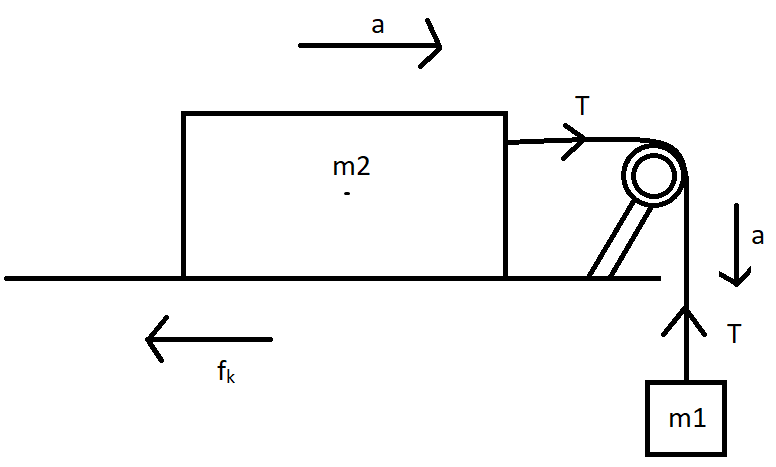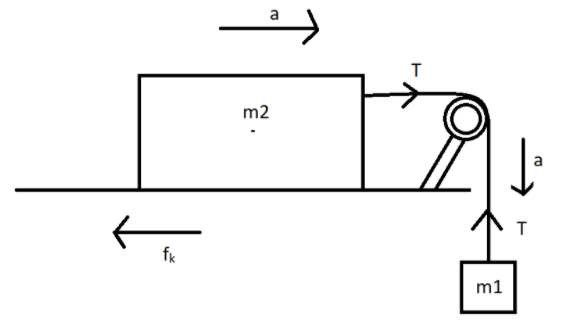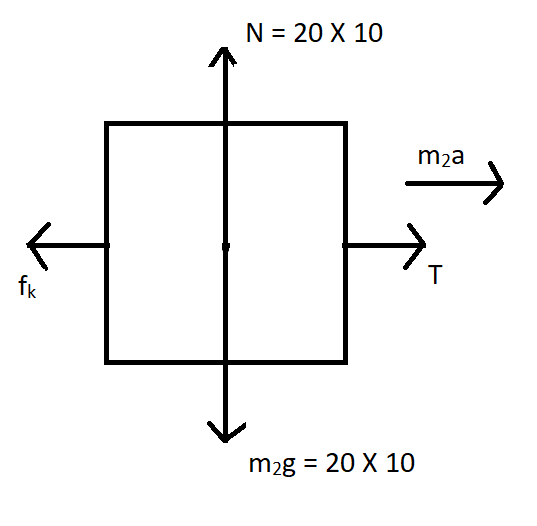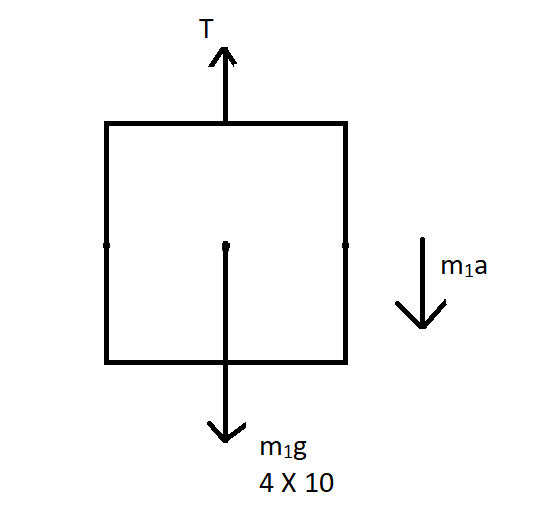
The coefficient of kinetic friction is

A.
B.
C.
D.

Answer
451.8k+ views
Hint: To solve this question we must know what acceleration means. Acceleration can be defined as the rate of change of the velocity of an object with respect to time. Acceleration is a vector quantity which means they have both magnitude and direction. According to Newton's second law ‘the acceleration of an object (a) is proportional to the force (F) applied on it’, and the proportionality factor is the object's mass (m).
Complete answer:

Given that,
Mass of
Mass of
Coefficient of kinetic friction is given by,
Let the acceleration of blocks be ‘a’
Now consider free body diagram of

Its equation of motion is given by,
Now by considering

Hence by adding both the equation we get
Hence the acceleration of the block is
Note:
The three types of acceleration are as follows-
Uniform acceleration: When an object is travelling in a straight line with an increase in velocity at equal intervals of time, then the object is said to be in uniform acceleration. Free falling of an object is said to be an example of uniform acceleration.
Non-uniform acceleration: When an object is travelling with an increase in velocity but not at the equal intervals of time is known as non-uniform acceleration. Bus moving or leaving from the bus stop is an example of non-uniform acceleration.
Instantaneous acceleration: Acceleration of an object at any instant of time is known as instantaneous acceleration.
Complete answer:

Given that,
Mass of
Mass of
Coefficient of kinetic friction is given by,
Let the acceleration of blocks be ‘a’
Now consider free body diagram of

Its equation of motion is given by,
Now by considering

Hence by adding both the equation we get
Hence the acceleration of the block is
Note:
The three types of acceleration are as follows-
Uniform acceleration: When an object is travelling in a straight line with an increase in velocity at equal intervals of time, then the object is said to be in uniform acceleration. Free falling of an object is said to be an example of uniform acceleration.
Non-uniform acceleration: When an object is travelling with an increase in velocity but not at the equal intervals of time is known as non-uniform acceleration. Bus moving or leaving from the bus stop is an example of non-uniform acceleration.
Instantaneous acceleration: Acceleration of an object at any instant of time is known as instantaneous acceleration.
Latest Vedantu courses for you
Grade 7 | CBSE | SCHOOL | English
Vedantu 7 CBSE Pro Course - (2025-26)
School Full course for CBSE students
₹45,300 per year
Recently Updated Pages
Master Class 9 General Knowledge: Engaging Questions & Answers for Success

Master Class 9 English: Engaging Questions & Answers for Success

Master Class 9 Science: Engaging Questions & Answers for Success

Master Class 9 Social Science: Engaging Questions & Answers for Success

Master Class 9 Maths: Engaging Questions & Answers for Success

Class 9 Question and Answer - Your Ultimate Solutions Guide

Trending doubts
State and prove Bernoullis theorem class 11 physics CBSE

Who built the Grand Trunk Road AChandragupta Maurya class 11 social science CBSE

1 ton equals to A 100 kg B 1000 kg C 10 kg D 10000 class 11 physics CBSE

State the laws of reflection of light

One Metric ton is equal to kg A 10000 B 1000 C 100 class 11 physics CBSE

Difference Between Prokaryotic Cells and Eukaryotic Cells




